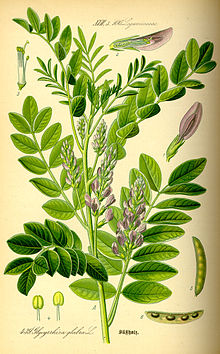Liquorice
| Liquorice | |
|---|---|

| |
| Scientific classification | |
| Kingdom: | Plantae |
| Clade: | Tracheophytes |
| Clade: | Angiosperms |
| Clade: | Eudicots |
| Clade: | Rosids |
| Order: | Fabales |
| Family: | Fabaceae |
| Subfamily: | Faboideae |
| Clade: | Inverted repeat-lacking clade |
| Genus: | Glycyrrhiza |
| Species: | G. glabra
|
| Binomial name | |
| Glycyrrhiza glabra | |
| Synonyms[2][3][4] | |
| |
Liquorice (British English) or licorice (American English; IPA: /ˈlɪkərɪʃ, -ɪs/ LIK-ər-ish, -iss)[5][6] is the common name of Glycyrrhiza glabra, a flowering plant of the bean family Fabaceae, from the root of which a sweet, aromatic flavouring is extracted.[7]
The liquorice plant is an
Liquorice extracts have been used in
Etymology
The word liquorice, or licorice, is derived via the Anglo-French lycorys, from Late Latin liquiritia,[10] itself ultimately derived from Greek γλυκύρριζα, glykyrrhiza (the Modern Greek spelling of the genus is γλυκόριζα, glykoriza)[11] literally meaning 'sweet root' and referring to Glycyrrhiza glabra.[12]
The latter gives the plant binomial name with glabra meaning smooth[13] and referring to the plant's smooth husks; the former came to being via the influence of liquere, 'to become fluid', reflecting the method of extracting the sweet component from the roots.[14]
As of 2021[update], its English common name is spelled 'liquorice' in most of the Commonwealth, but 'licorice' is also used in some countries.[7][15][16]
Description
Liquorice is a
Chemistry


Liquorice root contains triterpenoids, polyphenols, and polysaccharides.[8] Flavonoids account for the yellow root color.[8] The principal glycoside, glycyrrhizin, exists in content of 7% to 10%, depending on cultivation practices.[8] The isoflavene glabrene and the isoflavane glabridin, found in the roots of liquorice, are phytoestrogens.[19][20]
The scent of liquorice root comes from a complex and variable combination of compounds, of which anethole is some 3% of total volatiles.[citation needed] Much of the sweetness in liquorice comes from glycyrrhizin, which has 30–50 times the sweetness of sugar.[citation needed] The sweetness is different from sugar, being less instant, tart, and lasting longer.
Cultivation and uses
Liquorice grows best in well-drained soils in deep valleys with full sun. It is harvested in the autumn two to three years after planting.[17] Countries producing liquorice include Turkey, Greece, Iran, and Iraq.[8]
Tobacco
Liquorice is used as a flavouring agent for
Food and confectionery

Liquorice flavour is found in a wide variety of
In the Netherlands, liquorice confectionery (drop) is a common sweet sold in many forms. Mixing it with
Dried sticks of the liquorice root are a traditional confectionery in the Netherlands as were they once in Britain. They were sold simply as sticks of zoethout ('sweet wood') to chew on as a candy.

Pontefract in Yorkshire, England, is where liquorice mixed with sugar began to be used as a sweet in the contemporary way.[23] Pontefract cakes were originally made there.[24] In Cumbria, County Durham, Yorkshire and Lancashire, it is colloquially known as 'Spanish', supposedly because Spanish monks grew liquorice root at Rievaulx Abbey near Thirsk.[25]
In Italy, Spain and France, liquorice is used in its natural form. The root of the plant is simply harvested, washed, dried, and chewed as a mouth freshener. Throughout Italy, unsweetened liquorice is consumed in the form of small black pieces made only from 100% pure liquorice extract. In Calabria, a liqueur is made from pure liquorice extract and in Reggio Emilia a soft drink called acqua d'orcio is made. Liquorice is also used in Syria and Egypt.
In southeastern Turkey, such as in Diyarbakır, licorice root is traditionally made into a chilled beverage that is most commonly consumed in summer.[26]
Research
Properties of glycyrrhizin are under preliminary research, such as for
Traditional medicine
In traditional Chinese medicine, a related species G. uralensis (often translated as "liquorice") is known as gancao (Chinese: 甘草; lit. 'sweet grass'), and is believed to "harmonize" the ingredients in a formula.[28] although there is no high-quality clinical research to indicate it is safe or effective for any medicinal purpose. The European Medical Agency added liquorice to their list of herbal medicine.[29]
Fungicide
The essential oils inhibit the growth of Aspergillus flavus.[30]
Adverse effects
Consumption levels
The United States
Because the composition of liquorice extracts in various products may exist in a broad range, there is not enough scientific information to determine that a specific level of intake is safe or unsafe.[7][8]
Physiological effects
The effects of excessive liquorice consumption on lowering potassium levels in the blood and increasing blood pressure are a particular concern for people with hypertension (high blood pressure) or heart or kidney disease.[7]
Some adverse effects of liquorice consumed in amounts of 50 to 200 g per day over four weeks appear to be caused by
Hyper-
Other adverse effects may include electrolyte imbalance, edema, increased blood pressure, weight gain, heart problems, and weakness. Symptoms depend on the severity of toxicity. Some other complaints include fatigue, shortness of breath, kidney failure, and paralysis.[33][34]
Potential for toxicity
The major dose-limiting toxicities of liquorice are
Gallery
-
Liquorice root with bark
-
Inflorescence of G. glabra
-
Various liquorice products
-
Different flavoured liquorice sticks
-
Foliage
-
G. glabra from Koehler's Medicinal-Plants
References
- ^ a b "Glycyrrhiza glabra". Germplasm Resources Information Network. Agricultural Research Service, United States Department of Agriculture. Retrieved 6 March 2008.
- ^ "The Plant List: A Working List of All Plant Species". Retrieved 2017-03-07.
- ^ "Glycyrrhiza pallida Boiss., Diagn. Pl. Orient. ser. 2, 2: 22 (1856)". The International Plant Names Index. Retrieved 2017-03-07.
- ^ "Glycyrrhiza violacea Boiss., Diagn. Pl. Orient. ser. 2, 2: 23 (1856)". The International Plant Names Index. Retrieved 2017-03-07.
- ^ "Liquorice". Dictionary.com Unabridged (Online). n.d.
- ^ "Licorice". Dictionary.com Unabridged (Online). n.d.
- ^ a b c d e f g h i j k "Licorice root". National Center for Complementary and Integrative Health, US National Institutes of Health. August 2020. Retrieved 11 June 2023.
- ^ a b c d e f g h i j k l m n o p "Licorice". Drugs.com. 31 January 2022. Retrieved 11 June 2023.
- ^ PMID 23185686.
- New English DictionaryOn Historical Principles (NED). Vol. VI. L to N. Oxford, England: Clarendon Press. p. 332. Retrieved 2021-04-07.
- ^ "γλυκύρριζα". Epitome of the Kriaras Dictionary (online version) (in Greek). Center for the Greek Language. Portal for the greek language. Retrieved 2021-04-07.
- Perseus Project.
- Perseus Project.
- ^ Harper D. "Licorice". Online Etymology Dictionary.
- ^ "Liquorice". Merriam-Webster.com Dictionary.
- ^ "Licorice". Merriam-Webster.com Dictionary.
- ^ ISBN 0-333-47494-5
- ISBN 1-4053-0059-0
- S2CID 16238533.
- S2CID 40171833.
- ^ Erik Assadourian, Cigarette Production Drops Archived 2011-12-09 at the Wayback Machine, Vital Signs 2005, at 70.
- ^ "Flavored Tobacco". US Food and Drug Administration. 22 September 2009. Retrieved 21 December 2017.
- ^ "Right good food from the Ridings". AboutFood.com. 25 October 2007. Archived from the original on 7 June 2007.
- ^ "The strange story of Britain's oldest sweet". BBC Travel. 2019-07-11.
- ^ "Where Liquorice Roots Go Deep". Northern Echo. 13 September 2006. Retrieved 9 December 2008.
- ^ "Lemon, Licorice and Sumac Sherbet: Drinks to beat the Summer Heat". Mediterranean Observer. 22 August 2021. Archived from the original on 29 March 2023.
- S2CID 4394282.
- ISBN 978-0-939616-42-8.
- ^ "Liquiritiae radix". European Medicines Agency. Retrieved 1 June 2021.
- S2CID 104427400.
- PMID 8386690.
- PMID 2161425.
- PMID 6986557.
- PMID 4059165.
- S2CID 39005138.
- PMID 12373628.
External links
- . Encyclopædia Britannica. Vol. 16 (11th ed.). 1911.
- Glycyrrhiza glabra (licorice), Kew plant profile
- What's That Stuff?: Licorice, Chemical & Engineering News






